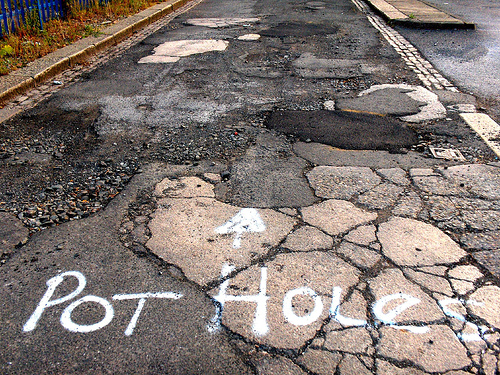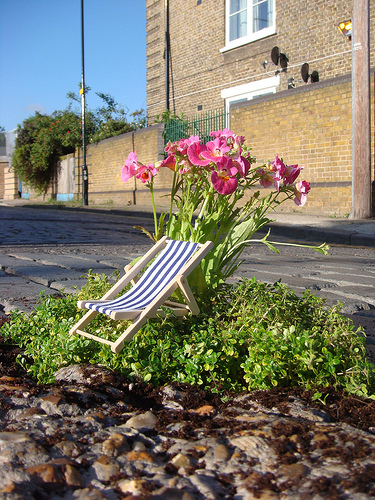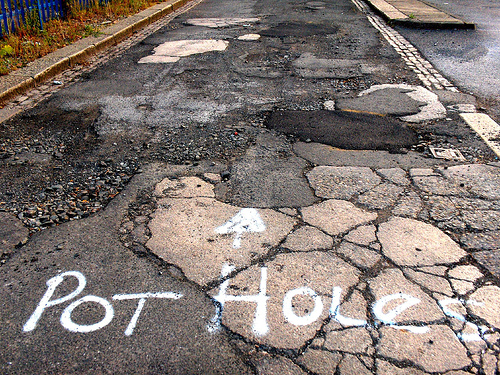 Photo: Topsy Qur’etThis may be the “most wonderful time of the year” for holiday music fans, but it’s a terrible time to drive: Constant freezing and thawing and the pounding of holiday traffic create craters in the asphalt large enough to swallow a Cooper Mini, leaving us to pick our way through a minefield of potholes.
Photo: Topsy Qur’etThis may be the “most wonderful time of the year” for holiday music fans, but it’s a terrible time to drive: Constant freezing and thawing and the pounding of holiday traffic create craters in the asphalt large enough to swallow a Cooper Mini, leaving us to pick our way through a minefield of potholes.
But who says that’s such a bad thing?
Potholes are a perennial topic of griping in cities worldwide, given their tendency to damage unsuspecting vehicles, threaten bicyclists, and impede all modes of traffic. We debate their origin (“Did they really start in ancient Rome?”), allow them a starring role in politics, build tougher cars to withstand them, and blame budget shortfalls for their long lives.
Ironically, because most potholes are located firmly within the public domain, private sector or charitable attempts to fix them are often deemed inappropriate by transportation officials: These non-public remedies could speed things up, but they may not meet public road standards for materials or safety. Websites such as Pothole.info regularly chronicle the associated political challenges for mayors around the world.
But some private attempts at pothole repair show promise. In one case, reported last March, a San Diego man performed a self-repair in front of his house without incident. Earlier, in the Portland area, a pavement company made news by filling potholes for people who agreed to make donations to a list of local charities through the “Potholes for Poverty” program.
Meanwhile, abroad, one town in Germany resorted to selling potholes for 50 Euros apiece to fund repair — and, perhaps surprisingly, the price was right, again and again. Here’s a video about it:
But really, what’s so bad about potholes? Nothing, from the problem-as-opportunity point of view. They’re great at slowing traffic and discouraging car travel. Seen in this light, potholes could become the universal darlings of walkable urbanism.
 Photo: thepotholegardenerIn the interests of health and safety, if potholes are going to be unattended risks, why not mark them with style like Steve Wheen, London’s pothole gardener? Wheen regularly creates miniature versions of the English garden, adapted to such small spaces with kamikaze grace.
Photo: thepotholegardenerIn the interests of health and safety, if potholes are going to be unattended risks, why not mark them with style like Steve Wheen, London’s pothole gardener? Wheen regularly creates miniature versions of the English garden, adapted to such small spaces with kamikaze grace.
Indeed, make them monuments, green them up — or, more purposefully, fence them off — as yet another pocket of reclaimed guerrilla urbanism. Make those nasty, cordoned-off potholes what they already are: untouchable neighborhood open space, some suitable for dog walk way-stations (with scoopers, plastic bags, and special disposal containers), others for green space with exotic vegetation, or traffic-calming devices of various shapes and sizes.
Such altered potholes could become the new traffic-calming “woonerfs” — those shared spaces in intersections or roadsides borrowed from the Dutch, and already present in some Seattle neighborhoods. Woonerfs make us drive slower, as we must navigate around them to get from here to there, and they are often aimed at increased pedestrian presence on autocentric streets. Think of woonerfs — and the new pothole mini-parks — as Park(ing) Day on steroids.
And that’s the point. Potholes could be permanent, in a good way — which might just accelerate some people’s desired evolution away from the car.



